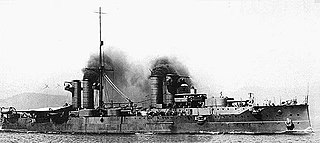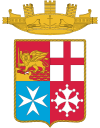
Giuseppe Garibaldi is an Italian aircraft carrier, the first through-deck aviation ship ever built for the Italian Navy, and the first Italian ship built to operate fixed-wing aircraft. Although she is widely recognised as a carrier first and foremost, she is officially designated as an aircraft-carrying cruiser. She is equipped with short take-off and vertical landing (STOVL) aircraft and helicopters. Giuseppe Garibaldi was involved in combat air operations off Somalia, Kosovo, Afghanistan and Libya.

The Italian Navy is the navy of the Italian Republic. It is one of the four branches of Italian Armed Forces and was formed in 1946 from what remained of the Regia Marina after World War II. As of August 2014, the Italian Navy had a strength of 30,923 active personnel, with approximately 184 vessels in service, including minor auxiliary vessels. It is considered a multiregional and a blue-water navy.

Vettor Pisani was the lead ship of her class of four submarines built for the Regia Marina during the late 1920s. She was named after Vettor Pisani, a Venetian admiral. The submarine played a minor role in the Spanish Civil War of 1936–1939 supporting the Spanish Nationalists.
Enrico Toti was one of four Balilla-class submarines built for the Regia Marina during the late 1920s. The boat played a minor role in the Spanish Civil War of 1936–1939 supporting the Spanish Nationalists. She was the only Italian submarine to have sunk a Royal Navy submarine during the Second World War.

Godetia (A960) was a command and logistical support ship of the Belgian Naval Component, launched on 7 December 1965 at the Boelwerf in Temse and entered service on 2 June 1966. The patronage of Godetia was accepted by the city of Ostend. She was the first of two support ships acquired to replace World War II-era ships. Used primarily to provide logistic support to Belgium's fleet of minesweepers, Godetia has also seen service as a training ship, royal yacht and fisheries protection. The vessel has served with NATO's Standing NATO Mine Countermeasures Group 1 in the Baltic and North seas. In June 2021, Godetia was taken out of service.

The Balilla class were the first submarines to be built for the Italian navy following the end of World War I. They were large ocean-going cruiser submarines designed to operate in the Indian Ocean based in Italy's East African colonies. The design was double-hulled and based on the German Type UE 2 U-boats, one of which, U-120 was supplied to the Italians as a war reparation. A 425 horsepower (317 kW) auxiliary diesel engine was installed as an extra generator.

Nicoloso da Recco was one of a dozen Navigatori-class destroyers built for the Regia Marina in 1930. Named after the Italian Renaissance seaman Nicoloso da Recco, she served during World War II in which she was the sole survivor of her destroyer class. She shot down three Beaufort bombers while escorting a two-freighter convoy on 21 June 1942 off Tunisia. On 2 December 1942 Nicoloso Da Recco took part of the Battle of Skerki Bank, where an Italo-German convoy carrying troops and supplies to Libya was obliterated by Allied naval forces. Nicoloso Da Recco was the only vessel of her class to survive the war, and was eventually scrapped in July 1954.

Cantabria (A15) is a Replenishment oiler operated by the Spanish Navy. Acquired to provide logistical support for the Spanish fleet, Cantabria was commissioned in 2010. Cantabria is the second-largest naval ship currently operated by the Spanish, behind Juan Carlos I.

The San Giorgio class consisted of two armored cruisers built for the Royal Italian Navy in the first decade of the 20th century. The second ship, San Marco, was used to evaluate recently invented steam turbines in a large ship and incorporated a number of other technological advances. The ships participated in the Italo-Turkish War of 1911–1912, although San Giorgio was under repair for most of the war. San Marco supported ground forces in Libya with naval gunfire and helped them to occupy towns in Libya and islands in the Dodecanese. During World War I, the ships' activities were limited by the threat of Austro-Hungarian submarines, although they did bombard Durazzo, Albania in 1918.

Etruria was a protected cruiser of the Italian Regia Marina built in the 1891 by the Cantiere navale fratelli Orlando shipyard of Livorno. She was the third of six vessels of the Regioni class, all of which were named for current, or in the case of Etruria, former regions of Italy. The ship was equipped with a main armament of four 15 cm (5.9 in) and six 12 cm (4.7 in) guns, and she could steam at a speed of 18 knots.

The Vulcano-class is a class of replenishment oiler used by the Italian Navy, with lead ship Vulcano of the class entered service on 12 March 2021. The ships are designed to support fleet operations with fuel and dry stores and expected to replace Stromboli class, another class of replenishment oiler from the Navy. Vulcano was financed under the 2014 Naval Law, for €346 million, then increased to €374.6 million, when the length was extended by 12 metres (39 ft). A second ship Atlante was ordered in January 2022 for projected delivery in 2025. The Navy also had an option for a third ship of the class. However, under the Italian MoD’s Multi-Year Defence Planning Document for the 2023-2025 timeframe, a fourth ship was added to the program.

The Etna class is a ship class of two naval replenishment and logistic support ships used by the Italian Navy and by the Greek Navy The two ships are almost identical but they have differences in their armament and sensor equipment.

The Akar class is a series of two replenishment oilers and fleet support ships, designed and built for service in the Turkish Navy. The lead ship of the class, TCG Akar, was constructed in 1982–1983 and entered service in 1987. The second ship, TCG Yarbay Kudret Güngör, was constructed in 1993–1994 and entered service in 1995. Both ships were constructed in Turkey, though Yarbay Kudret Güngör was the first ship built for the Turkish Navy by a private shipyard. Both vessels remain in service.

Borea was one of eight Turbine-class destroyers built for the Regia Marina during the late 1920s. She was named after a northerly wind, Borea, bringing frigid, dry air to the Italian peninsula. The ship played a minor role in the Spanish Civil War of 1936–1937, supporting the Nationalists.

Freccia was the lead ship of her class of four destroyers built for the Regia Marina in the early 1930s. Completed in 1931, she served in World War II and previous conflicts.
Galileo Ferraris was one of four Archimede-class submarines built for the Regia Marina during the early 1930s. She played a minor role in the Spanish Civil War of 1936–1939 supporting the Spanish Nationalists.
The Settembrini class was a pair of submarines built for the Regia Marina during the late 1920s. They played a minor role in the Spanish Civil War of 1936–1939 supporting the Spanish Nationalists.
The Bandiera-class submarines were built for the Regia Marina during the late 1920s. They played a minor role in the Spanish Civil War of 1936–1939 supporting the Spanish Nationalists.

The Pisani-class submarines were built for the Regia Marina during the late 1920s. They played a minor role in the Spanish Civil War of 1936–1939 supporting the Spanish Nationalists.
Luigi Settembrini was the lead ship of her class of two submarines built for the Regia Marina during the early 1930s. She played a minor role in the Spanish Civil War of 1936–1939 supporting the Spanish Nationalists.















